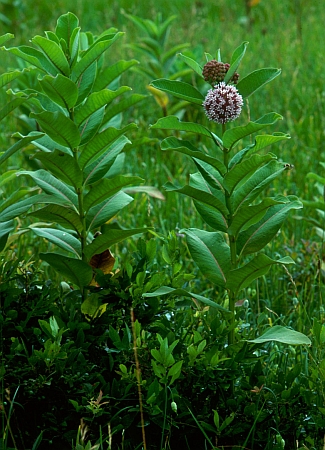Contents:
Common Names | Parts Usually Used | Plant(s) & Culture | Where Found | Medicinal Properties | Biochemical Information
Legends, Myths and Stories | Uses | Formulas or Dosages | Warning | Bibliography
Scientific Names

- Asclepias syriaca L.
- Asclepiadaceae
- Milkweed family
Common Names
- Common milkweed
- Common silkweed
- Cotton-weed
- Milkweed root
- Pai-t’u-huo (Chinese name)
- Silkweed
- Silky swallow-wort
- Snake milk
- Emetic root
- Milk ipecac
- Swallow-wort
- Virginia silk
Parts Usually Used
Rootstock
Back to Top
Description of Plant(s) and Culture
Milkweed is a common, milky-juiced, downy perennial plant; the simple, usually solitary, erect stem grows 3-6 feet high and bears opposite, relatively large, oblong-ovate to oblong, short-petioled leaves. Terminal or lateral umbels of small, dull purple flowers, often drooping in clusters from leaf axils; appear from June to August. Warty seedpods distinguish this species from other milkweeds.
Other varieties: Swamp milkweed (Asclepias incarnata); Four-leaved milkweed (A. quadrifolia).
Back to Top
Where Found
Found in fields, roadsides, fence rows, and waste places of eastern North America, as far west as Kansas and Saskatchewan. The most common milkweed in the Northeast.
Back to Top
Medicinal Properties
Diuretic, emetic, purgative, alterative, tonic
Back to Top
Biochemical Information
Asclepiadin, asclepion, and galitoxin
Back to Top
Legends, Myths and Stories
One species of the milkweed family in the Far East was possibly used as a hallucinogen, which is known in the Hindu religion as “Soma”.
The genus name, Asclepiadaceae, is named in honor of the Greek God Asclepius (God of medicine).
Native Americans used the juice of milkweed and tea from the leaves of creosote bush as poultices to draw out poison. Shoshone name for mildweed “Banumb.” The Shoshones break the tall milkweed and collect the milk and roll it in the hand, until it becomes firm enough to chew. Tonopah and Beatty call it “Samoko.”
Back to Top
Uses
Milkweed is useful for kidney problems, dropsy, scrofula, conditions of the bladder, water retention, asthma, stomach ailments, and gallstones, female disorders, arthritis, bronchitis. Causes increase in perspiration, thus reducing fever. Some Native Americans rubbed the (latex) juice on warts, moles, ringworms; others drank an infusion of the rootstock to produce temporary sterility or as a laxative. A folk cancer remedy.
One Mohawk antifertility concoction contained milkweed and Jack-in-the-pulpit, both considered dangerous and contraceptive.
Native Americans used the inside fibers for rope and fishing nets; the milk was collected and rolled until firm enough to make chewing gum (not recommended). The boiled root tastes like asparagus. The green plant is collected when very small and boiled in 2 waters to use as greens. We do not advise this for the general public as the amount and correct species is of importance in quantity. Correct identification is significant. Some milkweed species are highly poisonous.
Back to Top
Formulas or Dosages
Infusion: for gallstones, mix equal parts milkweed and althea. Steep 1 tsp. in 1 cup boiling water. Take 3 cups over the course of a day, one of them hot on retiring.
Back to Top
Warning
Milkweed is poisonous in large quantities, especially for children.
May be dangerous for people over 55. Take no more than is necessary.
Contains cardioactive compounds.
Back to Top
Bibliography
![]() Back to Eden
Back to Eden, by Jethro Kloss; Back to Eden Publishing Co., Loma Linda, CA 92354, Original copyright 1939, revised edition 1994
![]() The Herb Book
The Herb Book, by John Lust, Bantam Books, 666 Fifth Avenue, New York, NY. copyright 1974.
![]() Chinese Medicinal Herbs
Chinese Medicinal Herbs, compiled by Shih-Chen Li, Georgetown Press, San Francisco, California, 1973.
![]() Eastern/Central Medicinal Plants
Eastern/Central Medicinal Plants, by Steven Foster and James A. Duke., Houghton Mifflin Company, 215 Park Avenue South, New York, NY 10000
![]() Indian Herbalogy of North America
Indian Herbalogy of North America, by Alma R. Hutchens, Shambala Publications, Inc., Horticultural Hall, 300 Massachusetts Avenue, Boston, Massachusetts 02115, 1973
![]() American Folk Medicine
American Folk Medicine, by Clarence Meyer, Meyerbooks, publisher, PO Box 427, Glenwood, Illinois 60425, 1973
![]() Indian Uses of Native Plants
Indian Uses of Native Plants, by Edith Van Allen Murphey, Meyerbooks, publisher, PO Box 427, Glenwood, Illinois 60425, copyright 1958, print 1990
![]() Prescription for Nutritional Healing, Fifth Edition: A Practical A-to-Z Reference to Drug-Free Remedies Using Vitamins, Minerals, Herbs & Food Supplements
Prescription for Nutritional Healing, Fifth Edition: A Practical A-to-Z Reference to Drug-Free Remedies Using Vitamins, Minerals, Herbs & Food Supplements, by James F. Balch, M.D. and Phyllis A. Balch, C.N.C., Avery Publishing Group, Inc., Garden City Park, NY
![]() Webster’s New World Dictionary
Webster’s New World Dictionary, Third College Edition, Victoria Neufeldt, Editor in Chief, New World Dictionaries: A Division of Simon & Schuster, Inc., 15 Columbus Circle, New York, NY 10023
 How Indians Use Wild Plants for Food, Medicine & Crafts
How Indians Use Wild Plants for Food, Medicine & Crafts, by Frances Densmore, Dover Publications, Inc., 180 Varick Street, New York, NY 10014, first printed by the United States Government Printing Office, Washington, in 1928, this Dover edition 1974
 The Rodale Herb Book: How to Use, Grow, and Buy Nature’s Miracle Plants (An Organic gardening and farming book)
The Rodale Herb Book: How to Use, Grow, and Buy Nature’s Miracle Plants (An Organic gardening and farming book), edited by William H. Hylton, Rodale Press, Inc. Emmaus, PA, 18049., 1974
